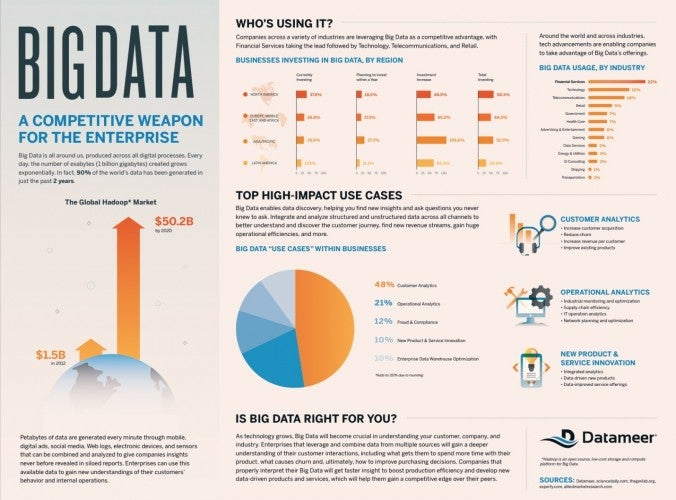Adobe Campaign Connects With Big Data

Big Data. Everyone is talking about it. Still, few are leveraging Big Data technologies to drive incremental business. As a data scientist and a digital marketer, I am excited about how Adobe Campaign is taking yet another step in providing brands the best access to available consumer data in Big Data databases (see DMA announcement here). We recognize Big Data is becoming more and more important in order for marketers to personalize and contextualize cross-channel experiences.
A couple years ago, a US congressman said “data is the new gold.” He was right. The value of data is in the nuggets of information we find when we analyze the incredible volumes of digitalized data.
The anticipation is incredible! Accenture found 89% of business leaders believe big data will revolutionize business operations in the same way the Internet did. Datameer discovered that nearly half (48%) of business leaders believe customer analytics will be a primary use for Big Data. Information Week revealed that finding correlations across multiple disparate data sources (48%), predicting customer behavior (46%), and predicting product or services sales (40%) are the three factors driving interest in Big Data analytics.

http://blogs.adobe.com/digitalmarketing/wp-content/uploads/2015/10/laxalt-fig1.jpg
Not only are Big Data technologies bringing better analytics capabilities, but the ability to store consumer data in massive, parallel cloud warehouses is one of the primary benefits of this transition to Big Data marketing. As of today, most companies use traditional data warehouse technologies, which have been fine solutions for a long time. But they contain only part of the equation.
Why is Real-time Big Data Essential to Running Effective Cross-channel Campaigns?
Because we are entering a new marketing era where message personalization and contextualization can make your campaign a success or a failure, the more good, clean data you have at your disposal, the more effective your message will be. Owned data only provides a part of the customer profile. Everything is becoming digitized, so massive volumes of nontransaction data are becoming available for companies in real time. This opens up the possibility to merge transaction and nontransaction data. Before long, the brands that will be able to best use Big Data in their marketing campaigns will be the ones that lead.
A Big Data database is a technology solution built on a new, innovative way of storing data, very different from what we have used in the past, such as NoSQL. It provides access to more robust nodes of data for marketing solutions such as Adobe Campaign. (This is why accessing Big Data is essential to running an effective cross-channel campaign). The challenge for most companies is to either pay significantly to upgrade legacy data warehouses to accommodate these new volumes of data or to access the new generation of “data reservoirs.” Without some way to access Big Data and combine it with owned data, marketers will be behind competitors who do access all the information available.
Adobe Campaign Connector to Amazon Redshift
Big Data solutions and existing data warehouses are both necessary for optimal use of customer data. So the Adobe Campaign team needed to find a way to provide flexibility for brand marketers querying both resources.
Amazon Redshift has joined the Big Data party and we at Adobe Campaign took notice. Among our 650 customers, some companies have begun to store part of their customer data in these new databases, like Redshift. So it made sense to build integration with Redshift into the Campaign solution.
Adobe Campaign’s new Redshift connector enables customers to store all their transactional data in Amazon Redshift, and seamlessly access the information—along with other key data points—to segment, target, and personalize communications. Let’s take an example:
A retailer is using Adobe Campaign to orchestrate its marketing campaigns across online and offline channels. This retailer is collecting more and more detailed data (purchases, Web navigations, iBeacon information, click throughs, etc.) but these data types may not be getting used often in its marketing campaigns. On a daily basis, the company’s marketers are instead using aggregate information like average purchase, product categories, etc. Due to capacity and system performance issues, the retailer decides to store the detailed transactional data in Redshift (because of the massive, parallel retrieval capabilities). However, on a case-by-case basis, the company’s marketers may need to use detailed transactional info in order to update a customer attribute or to personalize a 1to1 email message. With the new Redshift connector, the Adobe Campaign user can easily view the data coming from Redshift or the company’s legacy data warehouse without noticing the difference.
The New Future
As we believe Big Data technologies will be more and more popular among our customers, we’ll continue to unveil more connectors to big data solutions in the future. Check out all the Adobe Campaign features today.